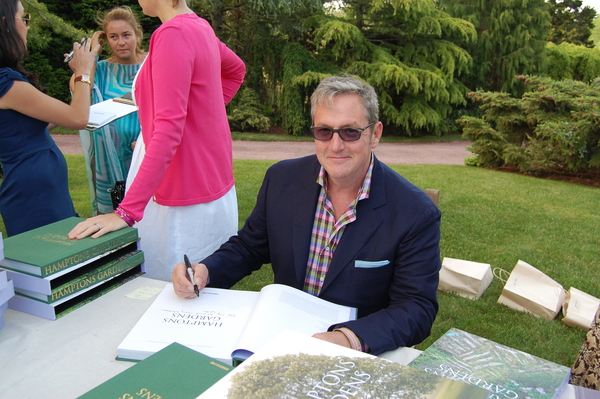
In putting together “Hamptons Gardens,” landscape architect Jack DeLashmet has truly outdone himself. The coffee-table book, a definitive visual exploration of some of the most beautiful landscapes on the East End, is a monster—10½-by-13½ inches and weighing in at 5 pounds—with page after page filled with fantastic flora planted on exceptional properties.
The 22 gardens featured, with photographs by Mary Ellen Bartley, Doug Young and Pamela Hanson, cover the gamut of what Mr. DeLashmet calls “the epicenter of garden design in America.” There are pictorials on lush landscapes, pastoral plots, cultivated courtyards, natural plantings, oceanside manses, a formerly infamous house (Grey Gardens in East Hampton), an orchard, a farm, and more.
And the variety doesn’t stop with garden type. In selecting what he wanted to include in the book, Mr. DeLashmet chose gardens created by his peers, only including four gardens of his own design.
“I collaborate a lot with my colleagues,” he said simply of his choice to feature the work of what could be considered his competition.
During a recent telephone interview, Mr. DeLashmet said that the thought behind the book, published by Assouline, was to show the gamut of great gardens on the East End, not just the estate gardens typically associated with the Hamptons.
“I had moved away from estate gardens, per se. I was trying to stay away from typical Hamptons gardens” he said, explaining that he was inspired by the large linen-covered antique picture books that he would pore over at his grandparents’ house in Mississippi when he was a boy. “We have beaches, we have estuaries, bayfront properties, former potato fields. There are so many microclimates here.”
Mr. DeLashmet said that the number-one criteria for winnowing down his selection from the hundreds of possible gardens—a most daunting task—was all about the microclimate.
“I adhered very strictly to my list of criteria,” he said. “What gardens are most important regarding the design or relationship to the microclimate in which they exist.”
The basic concept of the book is spelled out immediately in the introduction.
“To truly celebrate the genius loci, the Hamptons in all its many incarnations, I decided that I should draw from as many different habitats within the East End environment as I could,” Mr. DeLashmet wrote.
But choosing what to leave out was incredibly difficult, he reported.
“It was difficult to keep favoritism out of it, that was the most difficult part,” Mr. DeLashmet said.
Another important consideration in putting together “Hamptons Gardens” was how often a garden had been photographed.
“If it had been overly published, I did not include it in my book,” he said.
Mr. DeLashmet explained that there are three things that all the gardens in the book have in common: thoughtful design, cognizance of the surrounding climate, and a strong connection between designer and homeowner.
As to the thoughtful point: “Except for one garden, none of these was designed and delivered to a client or a homeowner finished; they were all done in the proper thoughtful manner,” Mr. DeLashmet said. “These were not just delivered on a silver platter, it was more an evolutionary way of thinking.”
Regarding cognizance: “People were cognizant of the genius loci of the place, whether they chose to ignore it or embrace it. If they were cutting the connection away, they made the decision very thoughtfully and judiciously,” he said.
And about the relationships: “No matter the scope of the garden, if a designer was involved in the process, the connection between the designer and the homeowner took on a tight personal relationship,” according to Mr. DeLashmet.
One of the featured gardens in “Hamptons Gardens” belongs to Barbara Slifka, who owns an oceanside beach house in Sagaponack. The gardens were designed by Eric Groft of Oehme, van Sweden & Associates. She said that she was thrilled to be included, and with the final result.
“The pictures they did were really lovely. They really caught the spirit of the house and the garden,” Ms. Slifka said during a telephone interview last week. “This is so pretty because they showed all the different angles. They just got it right.”
Mr. DeLashmet is equally pleased at how the book turned out.
“The final result was exactly what I envisioned. I’m walking on air,” he said. “It’s a snapshot in time in terms of what’s going on in the East End of Long Island, which shows the breadth of talent we have here.”
“Hamptons Gardens” is on sale now. All author proceeds will benefit God’s Love We Deliver. For additional information, visit assouline.com.